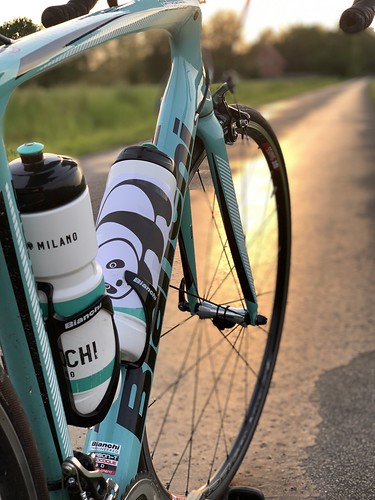Rated that these functional screens are capable to recognize crucial functions linked to certain cancer phenotypes. Specifically in breast cancer cells, these studies have revealed certain sensitivities related with luminal and basal subtypes [12, 15] and person mutated bona fide cancer genes [16, 17]. Thus, we decided to utilize this strategy to recognize IBCspecific sensitivities. By way of a genome-wide RNAi screen, we found and validated that the viability of IBC cells depends upon histone deacetylase six (HDAC6) function. HDAC6 is often a class IIb histone deacetylase localizing mostly in the cytosol, where it performs a diverse functional repertoire by means of deacetylation of various targets [180]. During the final decade, HDAC6 has emerged as a master regulator of your cellular protective response to cytotoxic accumulation of toxic bioproducts [180]. Importantly, there are actually smaller molecule inhibitors for HDAC6 presently becoming tested in advanced clinical trials for other tumor varieties (myeloma and lymphoid malignancies). Right here, utilizing both in vitro assays and in vivo preclinical studies, we demonstrated that Ricolinostat (ACY1215), a major HDAC6 inhibitor [21], attenuates progression of IBC. These findings provide a direct rationale to developing novel, efficient, and well-tolerated targeted therapies for IBC individuals.the other aliquote was  passed in culture. Lastly, gDNA was extracted once more immediately after 10 doubling instances (t10). Subsequent, we utilized NextGen-sequencing by way of the Illumina HiSeq 2000 at 100 bp TAK-220 custom synthesis resolution to analyze shRNA abundance at t0 and t10 time points [14, 224]. As a 1st step, it’s necessary to PCR out the shRNA library integrated inside the gDNA of every single cell population. For this, PCR-oligos that hybridize in a widespread region outside the shRNA are utilised. Just after this PCR, we receive a PCR item that contains the shRNA library using the same representation discovered inside the cell population analyzed. The hairpin sequence is extracted from the sequencing read and in comparison to the reference sequence. Maximum alignment scores are identified because the principal read; if a number of scores exist, the read is marked as ambiguous and not utilized. It is actually estimated that 75 of quick reads are verifiably read in genome-wide shRNA screens utilizing subsequent generation sequencing (NGS) for deconvolution. An expanded shRNA screen methodology can be located inside the supplementary material and strategies in Extra file 1).Pooled shRNA screen analytical approachOur ultimate target was to recognize genes that selectively compromise IBC cell viability when silenced. This evaluation was divided onto quite a few individual steps, as follows.Person shRNA analysisMethodsPooled shRNA screen experimental approachWe performed genome-wide pooled RNAi screens in 13 breast cancer cell lines (Added file 1, for any table using a comprehensive list and qualities from the cell lines employed). The library pool consists of 58,493 shRNAs integrated in to the backbone of miR-30 and cloned into the pGIPZ lentiviral vector (Open Biosystems GIPZ Lentiviral Human shRNA Library). These shRNAs target 18,661 human genes, which account for about 75 in the human genome. Cell lines had been transduced at a multiplicity of infection (MOI) 0.three in triplicate [12, 13]. PubMed ID:http://www.ncbi.nlm.nih.gov/pubmed/2129546 Immediately after library transduction, cells which have incorporated the GIPZ construct had been selected based on the puromycin choice expressed by the library constructs. The surviving cells had been permitted to recover for 24 hours. These cells were split into diverse aliqu.
passed in culture. Lastly, gDNA was extracted once more immediately after 10 doubling instances (t10). Subsequent, we utilized NextGen-sequencing by way of the Illumina HiSeq 2000 at 100 bp TAK-220 custom synthesis resolution to analyze shRNA abundance at t0 and t10 time points [14, 224]. As a 1st step, it’s necessary to PCR out the shRNA library integrated inside the gDNA of every single cell population. For this, PCR-oligos that hybridize in a widespread region outside the shRNA are utilised. Just after this PCR, we receive a PCR item that contains the shRNA library using the same representation discovered inside the cell population analyzed. The hairpin sequence is extracted from the sequencing read and in comparison to the reference sequence. Maximum alignment scores are identified because the principal read; if a number of scores exist, the read is marked as ambiguous and not utilized. It is actually estimated that 75 of quick reads are verifiably read in genome-wide shRNA screens utilizing subsequent generation sequencing (NGS) for deconvolution. An expanded shRNA screen methodology can be located inside the supplementary material and strategies in Extra file 1).Pooled shRNA screen analytical approachOur ultimate target was to recognize genes that selectively compromise IBC cell viability when silenced. This evaluation was divided onto quite a few individual steps, as follows.Person shRNA analysisMethodsPooled shRNA screen experimental approachWe performed genome-wide pooled RNAi screens in 13 breast cancer cell lines (Added file 1, for any table using a comprehensive list and qualities from the cell lines employed). The library pool consists of 58,493 shRNAs integrated in to the backbone of miR-30 and cloned into the pGIPZ lentiviral vector (Open Biosystems GIPZ Lentiviral Human shRNA Library). These shRNAs target 18,661 human genes, which account for about 75 in the human genome. Cell lines had been transduced at a multiplicity of infection (MOI) 0.three in triplicate [12, 13]. PubMed ID:http://www.ncbi.nlm.nih.gov/pubmed/2129546 Immediately after library transduction, cells which have incorporated the GIPZ construct had been selected based on the puromycin choice expressed by the library constructs. The surviving cells had been permitted to recover for 24 hours. These cells were split into diverse aliqu.